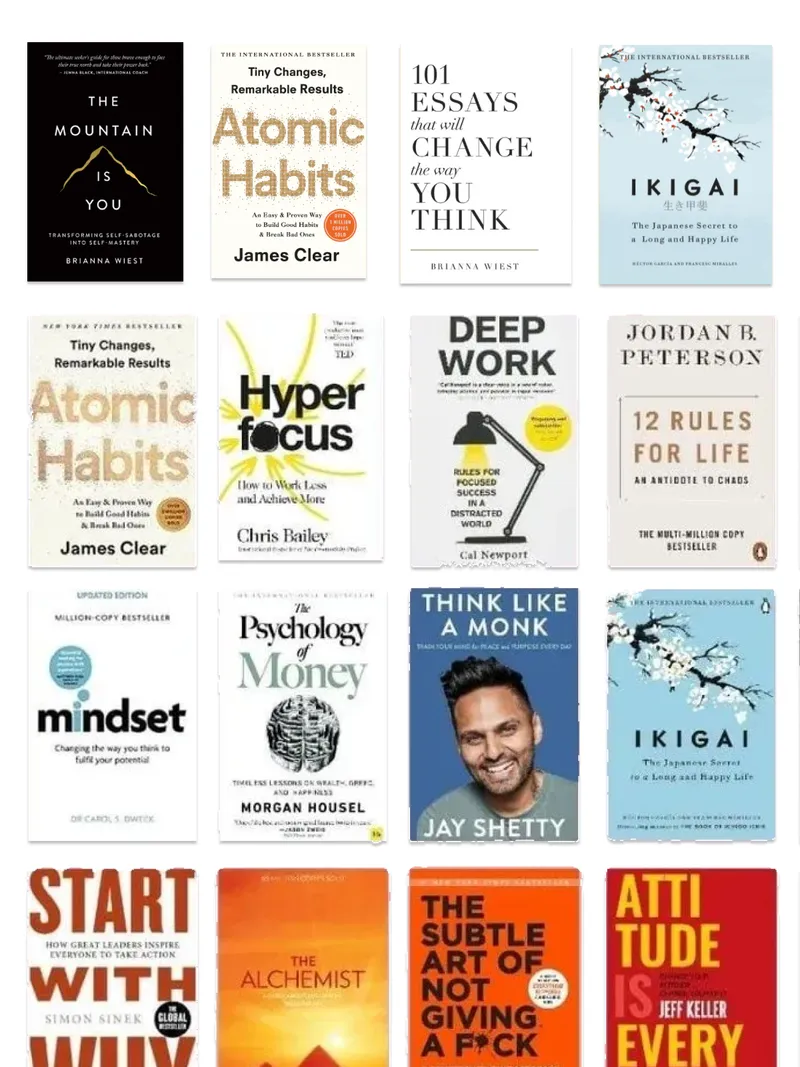The Essence of Self-Help Books

Many self-help and motivational books revolve around cultivating a growth mindset, setting clear goals, and taking consistent action. Of course, not every self-help book is rigorously grounded in science, but a significant number leverage research-backed methods such as implementation intentions, CBT-based reframing, and habit stacking to produce real, lasting change.
• Backed by scientific evidence, techniques like “If-Then” planning, CBT-based reframing, and habit stacking methods can help turn personal development principles into concrete strategies.
• In practice, this might look like breaking big goals into smaller steps, designing your environment to support your habits, or implementing regular routines like mood tracking and journaling.
Three Key Elements Commonly Promoted in Popular Self-Help and Motivational Books
1. Mindset and Belief in Personal Agency
Nearly all motivational and self-help literature emphasizes the power of a positive outlook—often referred to as a “growth mindset” (popularized by psychologist Carol Dweck). These books stress that believing in your capacity to change or improve is the first step toward making real progress.
2. Goal Setting and Vision
Whether it’s writing down clear objectives or visualizing success, setting a compelling vision for the future is a central theme. Many of these books argue that having specific, measurable goals helps channel motivation and keeps you focused on what truly matters.
3. Consistent Action and Habit Formation
The importance of daily discipline, small wins, and habit-building is another common thread. Rather than relying on willpower alone, these books often recommend creating routines or systems that make it easier to take consistent action toward your goals.
Three Science-Backed Methods Often Recommended
1. Implementation Intentions (“If-Then” Planning)
- What It Is: An evidence-based strategy from social psychology (Peter Gollwitzer’s research) that involves creating a specific plan for how you will respond to a given situation: “If situation X arises, then I will do Y.”
- Why It Works: By pre-deciding your response to common obstacles or triggers, you bypass the need for on-the-spot willpower. Research shows implementation intentions significantly increase the likelihood of following through on goals.
2. Cognitive Behavioral Techniques (CBT) for Reframing Thoughts
- What It Is: CBT is a well-established psychological approach that helps people identify and modify negative or distorted thought patterns. Techniques include:
- Catching Automatic Negative Thoughts
- Challenging and Replacing Them with Balanced Thoughts
- Why It Works: Numerous clinical studies have demonstrated CBT’s effectiveness in improving mood, motivation, and resilience. By learning to reframe thoughts, you develop a more constructive mindset and reduce self-sabotaging beliefs.
3. Habit Stacking and Environment Design
- What It Is: Rooted in behavioral science, habit stacking (popularized by BJ Fogg and James Clear) means linking a new habit to an existing routine—“After I brew my morning coffee, I will spend 5 minutes meditating.” Environment design involves arranging your surroundings to make desired behaviors easier (e.g., keeping healthy snacks visible, placing workout gear by the door).
- Why It Works: Research on behavior change shows that making the desired action simpler and removing friction increases follow-through. Habit stacking harnesses the cue of an already well-established habit, making new behaviors more “automatic.”
The Role of Mood Tracking, Journaling, and Habit Tracking
Many self-help practices now integrate mood tracking, journaling, and habit tracking to reinforce the changes recommended in popular books:
-
Mood Tracking: Regularly recording your emotional state provides valuable insight into patterns and triggers. When combined with CBT techniques, tracking your mood can help you spot unhelpful thought patterns and proactively work to reframe them.
- Example: Use a simple “mood meter” or an app each morning to note how you’re feeling—this can guide you in deciding which CBT strategies or supportive habits you should prioritize for the day.
-
Journaling: Writing down goals, reflections, or personal challenges promotes self-awareness and consolidates learning from self-help material. It also serves as a chronological record of your progress, helping you identify what’s working and where you might need to adjust.
- Example: Keep a small journal by your bedside and spend five minutes each night reflecting on one positive thing you accomplished or learned that day.
-
Habit Tracking: By systematically checking off each day you perform a desired habit (like exercising, meditating, or reading), you make your progress visible and build motivation through consistency. Many self-help books encourage some form of habit tracking to reinforce daily discipline.
- Example: Adopt a simple spreadsheet or use a habit-tracking app to mark completed habits. Over time, you’ll see patterns of progress—this visual reinforcement often helps combat discouragement.
Bringing It All Together
Self-help books that integrate science-backed strategies offer concrete tools to make personal development more effective. While not every title in this genre is rooted in empirical research, the overarching themes—mindset, goal setting, and consistent action—are often supported by methods like implementation intentions, CBT, and habit stacking. By weaving in regular practices such as mood tracking, journaling, and habit tracking, you can amplify the impact of these approaches.
Ultimately, success in personal growth is about understanding your unique needs, experimenting with proven techniques, and adapting them to your life. By staying curious, reflective, and consistent in your efforts, you stand a better chance of turning self-help principles into lasting transformation.


